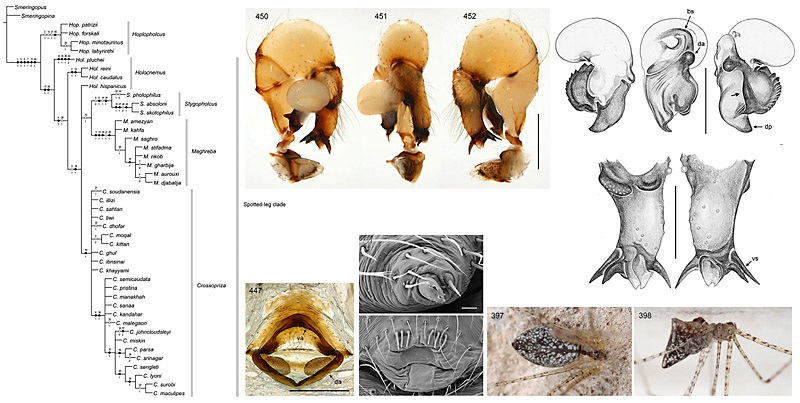Starting in 2012, I have tried to alleviate this situation with a series of taxonomic revisions and cladistic analyses. The first two monographs dealt with the southern clade of Smeringopinae, the Sub-Saharan sister-genera Smeringopus Simon, 1890 (Huber 2012) and Smeringopina Kraus, 1957 (Huber 2013). The third and fourth monographs focused on the West Asian and SE European genera Hoplopholcus Kulczyński, 1908 (Huber 2020) and Stygopholcus Kratochvíl, 1932 (Huber et al. 2021). The remaining genera (except for the small Seychellois endemic genus Cenemus Saaristo, 2001) appeared like the most problematic. Wiehle’s (1933) meticulous struggle (and failure) to find a convincing morphological distinction between Crossopriza and Holocnemus testifies both to the long history of the problem and to its intricacy.
Making things even worse, new material collected over the last decades in northwestern Africa (mainly Morocco) has complicated the situation further. These Moroccan and Algerian species seemed intermediate between Holocnemus and Crossopriza yet distinct from both.
The present paper was originally intended to terminate this series on Smeringopinae and to finally clarify the systematics of Holocnemus, Crossopriza, and the mysterious northwest African taxa. However, the available data allowed only a first step, i.e. a detailed redescription of all previously described species and the description of new species currently available in collections. A second step clearly has to follow: a step, in which phylogenetic relationships can finally be resolved convincingly. This paper presents a first comprehensive morphological cladistic analysis of Holocnemus and Crossopriza, but this is included primarily in order to point out characters that appear phylogenetically informative. Parts of the cladogram are unstable and thus neither convincing nor final. A more convincing solution will probably require the use of genomic data.
With now 158 species, Smeringopinae is still a relatively small subfamily, but one in which (1) almost all species are diagnosable, (2) most species have been included in phylogenetic analyses, and (3) distribution and diversity patterns can be described with reasonable accuracy.
